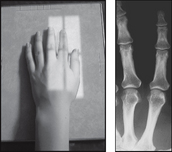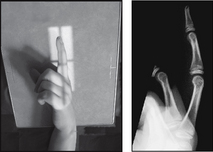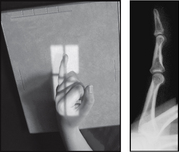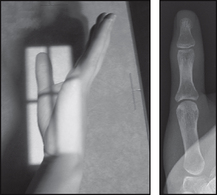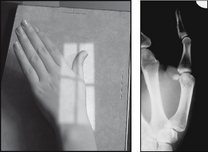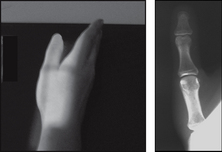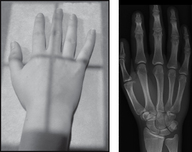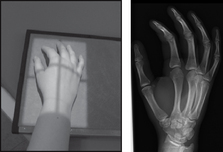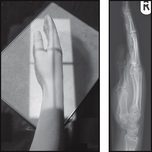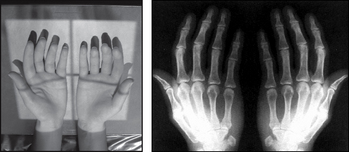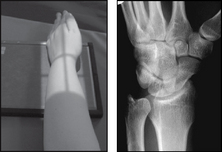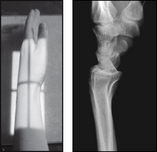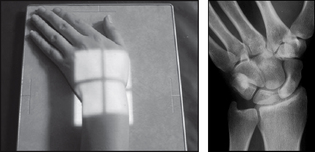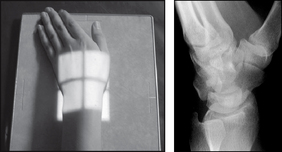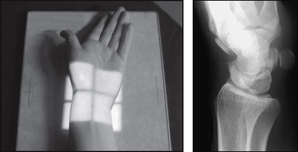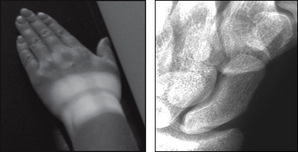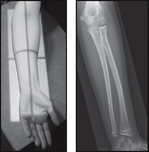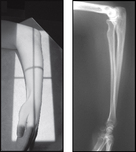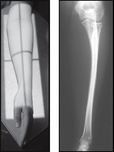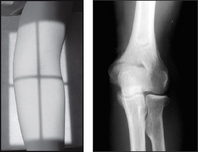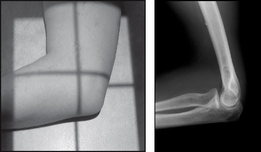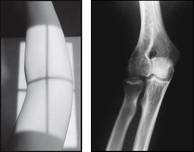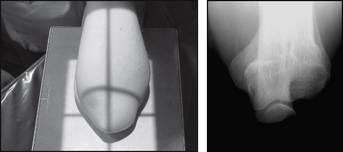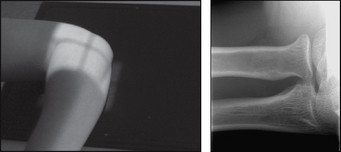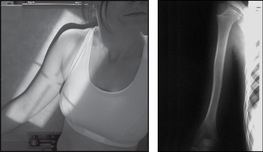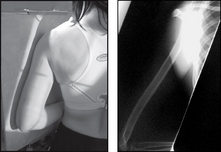1 Upper Extremity
FINGERS
Points to consider
Technique
PA (dorsipalmar) – affected finger
THUMB
Points to consider
AP
THUMB
HAND
Points to consider
Technique
Radiological assessment
![]() #s metacarpal neck – usually the result of a direct blow
#s metacarpal neck – usually the result of a direct blow
![]() Common site for #s – head of the fifth metacarpal – Boxer’s #
Common site for #s – head of the fifth metacarpal – Boxer’s #
![]() Look for vertical # through the base with dislocation of joint
Look for vertical # through the base with dislocation of joint
![]() Secondary ossification centres appear at age 2–3 years
Secondary ossification centres appear at age 2–3 years
![]() PA poor at showing #s of the articular surface of the metacarpal heads
PA poor at showing #s of the articular surface of the metacarpal heads
PA (dorsipalmar)
HAND
Projection: AP OBLIQUE (BALL CATCHER’s)
Centring Point: Midway between both hands at the level of the head of the fifth metacarpal
Points to consider
Technique
Radiological assessment
![]() Look for bone alignment – displacement and dislocation
Look for bone alignment – displacement and dislocation
![]() Look for # through the articular surface at the base of phalanx
Look for # through the articular surface at the base of phalanx
![]() Check the base of the fourth and fifth metacarpals – dislocation is common
Check the base of the fourth and fifth metacarpals – dislocation is common
![]() Ball catcher’s – look for early rheumatoid arthritis with loss of bony outline and associated demineralisation
Ball catcher’s – look for early rheumatoid arthritis with loss of bony outline and associated demineralisation
Lateral
AP oblique (ball catcher’s)
• Patient seated facing the X-ray table (use lead rubber gonad protection)
• Both forearms and hands are supinated
• Dorsa of both hands are in contact with the cassette and fifth metacarpals and phalanges are touching
• Hands are then internally rotated 45° as if to catch a ball
• Hands where indicated are supported in position with non-opaque pads
WRIST
Points to consider
Technique
![]() AP – elbow and wrist at the same level
AP – elbow and wrist at the same level
![]() Is there ulnar deviation if a scaphoid # is suspected?
Is there ulnar deviation if a scaphoid # is suspected?
![]() Slightly curl fingers so that carpals are in contact with cassette
Slightly curl fingers so that carpals are in contact with cassette
![]() Dry plaster of Paris cast increase 1 stud kV + 1 stud mAs
Dry plaster of Paris cast increase 1 stud kV + 1 stud mAs
![]() Wet plaster of Paris cast increase 2 stud kV + 1 stud mAs
Wet plaster of Paris cast increase 2 stud kV + 1 stud mAs
WRIST
SCAPHOID
Points to consider
Technique
Radiological assessment
![]() PA – the scaphoid and joint spaces should be demonstrated
PA – the scaphoid and joint spaces should be demonstrated
![]() 80% of #s occur at the waist of the scaphoid and jeopardise blood supply to the proximal part
80% of #s occur at the waist of the scaphoid and jeopardise blood supply to the proximal part
![]() Scaphoid # may not be evident for 5–10 days after injury – must have a follow-up examination
Scaphoid # may not be evident for 5–10 days after injury – must have a follow-up examination
![]() # of the proximal pole of scaphoid – increased chance of avascular necrosis
# of the proximal pole of scaphoid – increased chance of avascular necrosis
SCAPHOID
SCAPHOID
Centring Point: To the scaphoid – just distal to the anatomical snuff box. Central ray 45° towards the elbow
FOREARM
Points to consider
Radiological assessment
![]() AP – slight superimposition of radial head over proximal ulna
AP – slight superimposition of radial head over proximal ulna
![]() Lateral 2 – Good for bone alignment – radius and ulna superimposed
Lateral 2 – Good for bone alignment – radius and ulna superimposed
![]() But Lateral 2 – poor projection of the elbow – oblique elbow
But Lateral 2 – poor projection of the elbow – oblique elbow
![]() Lateral 1 – Good projection of the elbow and wrist joints
Lateral 1 – Good projection of the elbow and wrist joints
![]() Lateral 1 – Radius and ulna superimposed at the wrist, but separated at elbow
Lateral 1 – Radius and ulna superimposed at the wrist, but separated at elbow
ELBOW
Points to consider
Technique
![]() AP – epicondyles equidistant from the cassette
AP – epicondyles equidistant from the cassette
![]() AP – hand should be fully supinated
AP – hand should be fully supinated
![]() Lateral – raise and immobilise the wrist on non-opaque pad; alternatively ask the patient to support the wrist with their opposite hand placed beneath the wrist of the affected limb
Lateral – raise and immobilise the wrist on non-opaque pad; alternatively ask the patient to support the wrist with their opposite hand placed beneath the wrist of the affected limb
![]() Children – both elbows may be required for ossification centres
Children – both elbows may be required for ossification centres
Radiological assessment
AP
ELBOW
Points to consider
1. Possible injury to the radial head – general projection of the elbow joint
RADIAL HEAD
Projection: ALTERNATIVE PROJECTION
Centring Point: To the radial head. Central ray 45° to the humerus
HUMERUS
Points to consider
Technique
Radiological assessment
![]() #s occur at all levels – direct or indirect violence
#s occur at all levels – direct or indirect violence
![]() AP – head and greater tuberosity of humerus seen in profile
AP – head and greater tuberosity of humerus seen in profile
![]() Lateral – are the epicondyles superimposed?
Lateral – are the epicondyles superimposed?
![]() Common site in children – solitary bone cyst
Common site in children – solitary bone cyst
![]() Adults – metastatic deposits – breast or bronchus
Adults – metastatic deposits – breast or bronchus
![]() Lateral – head of humerus not seen well – shoulder projection may be required
Lateral – head of humerus not seen well – shoulder projection may be required
Lateral
• Patient may be prone or erect
• Body is rotated slightly onto the affected side so that the arm is in contact with the cassette – where possible and safe to do so the humerus is positioned completely clear of the thoracic wall
• Affected arm is carefully flexed and the hand is placed upon the upper abdomen
• Opposite arm is placed down by the side or the elbow flexed and hand used to support the hand/forearm of the injured side
